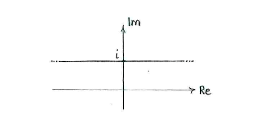Lösung 3.2:2e
Aus Online Mathematik Brückenkurs 2
Because the expression contains both \displaystyle z and \displaystyle \bar{z}, we write out \displaystyle z=x+iy, where \displaystyle x is the real part of \displaystyle z and \displaystyle y is the imaginary part. Thus, we have
\displaystyle \mathrm{Re}z=x
\displaystyle i+\bar{z}=i+(x-iy)=x+(1-y)i
and the condition becomes
\displaystyle x=x+(1-y)i \iff 0=(1-y)i
which means that \displaystyle y=1.
The set therefore consists of all complex numbers with imaginary part \displaystyle 1.

